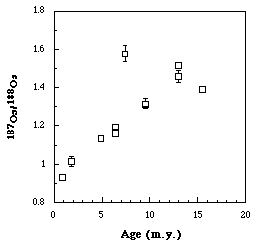
In 1992, Pegram et al. (1992) reported that the Os isotopic ratio of seawater, as determined from leachates of abyssal pelagic sediments, has increased dramatically since the Cretaceous-Tertiary boundary. The rate of increase was particularly high during the past 15 million years. These results were confirmed and extended by two recent studies of metalliferous sediments from the Pacific Ocean (Ravizza, 1993; Peucker-Ehrenbrink et al., 1995). One of the most commonly suggested explanantions for the change in the marine Os isotopic ratio, particularly for the rapid increase over the past 15 m.y., is the enhanced rate of erosion of rocks rich in radiogenic Os brought about by the uplift of the Himalayas. To test this hypothesis, we are analyzing sediments from two drillholes in the Bengal Fan (ODP Leg 116, Holes 717 and 718). To date, leachates from eight samples, plus three duplicates, have been analyzed, using the leaching technique described in Pegram et al. (1992). The results are shown in Fig. 1.
Several points are evident from this diagram. First, leachates of the youngest sediments (0.94 m.y.) yield a 187Os/188Os ratio of 0.93, which is equivalent to the ratio obtained from Pacific sediments of similar age (Pegram et al., 1992; Ravizza, 1993; Peucker-Ehrenbrink et al., 1995). This ratio is much lower than that of two leachates (187Os/188Os ~ 1.94) of Ganges River sediments reported by Pegram et al. (1994). Taken together, these observations suggest that the leachable portion of the river sediments (presumably ferromanganese phases (Pegram et al., 1994)) is released to seawater prior to deposition, so that the leachable Os present at the surface of the sediment column faithfully records the ambient Os isotopic composition of well-mixed seawater. Second, the sample that departs markedly from the trend defined by the other leachates has an age of 7.4 m.y. While this result should be repeated before interpretation, it is interesting to note that this age marks the beginning of a time of more intensive chemical weathering in the Ganges-Brahmaputra basin (France-Lanord et al., 1993).
Finally, and most importantly, the Os isotopic composition of the leachates increases markedly with sediment age. This is in sharp contrast to the behavior observed in other studies (Pegram et al., 1992; Ravizza, 1993; Peucker-Ehrenbrink et al., 1995), which showed a clear decrease in 187Os/188Os with increasing age. The reasons for this increase with age are not yet clear, but probably involve diagenesis of radiogenic sediments in the thick sedimentary column. Such processes may be enhanced by the active thermo-convective circulation system modelled for the
sedimentary pile in this region (Ormond et al., 1995). If the radiogenic Os observed in the leachates of sediments collected at depth is available for exchange with seawater, either through diffusion or through convective circulation, then the sediments derived from Himalayan erosion may indeed play an important role in determining the Os isotopic composition of the oceans.
France-Lanord, C., Derry, L. & Michard, A., In Himalayan Tectonics (Treloar, P.J. & Searle, M., eds.) 603-621 (1993).
Ormond, A., Boulègue, J. & Genthon, P., J. Geophys. Res. 100, 8083-8095 (1995).
Peucker-Ehrenbrink, B., Ravizza, G. & Hofmann, A.W., Earth Planet. Sci. Lett. 130, 155-167 (1995).
Pegram, W.J., Esser, B.K., Krishnaswami, S. & Turekian, K.K., Earth Planet. Sci. Lett. 128, 591-599 (1994).
Pegram, W.J., Krishnaswami, S., Ravizza, G.E. & Turekian, K.K., Earth Planet. Sci. Lett. 113, 569-576 (1992).
Ravizza, G., Earth Planet. Sci. Lett. 118, 335-348 (1993).
Fig. 1: Os isotopic compositions of leachates of Bengal Fan sediments vs. age.